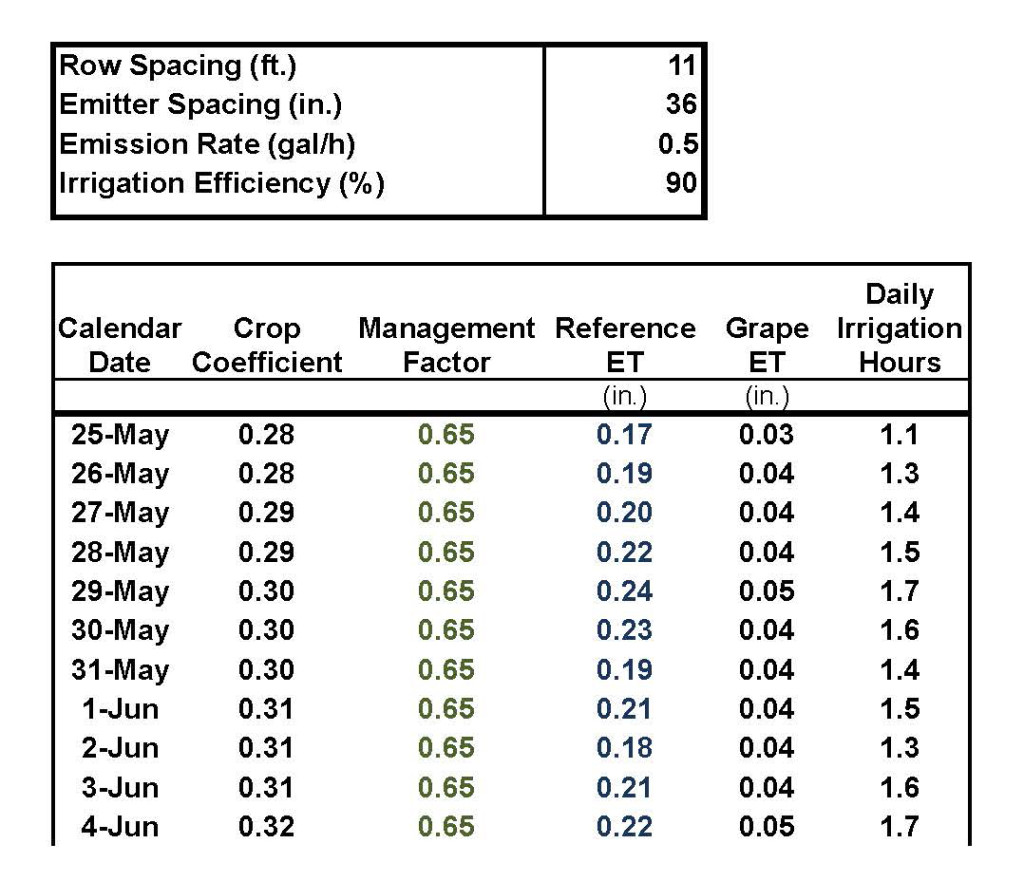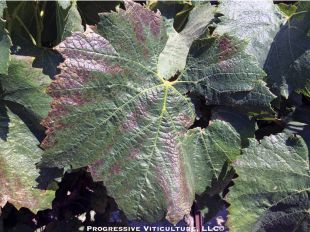 Part I of this series presented basic concepts of regulated deficit irrigation (RDI), early season soil moisture management, and the vine component of the soil-vine-atmosphere moisture continuum. In this posting, we will explore the other components of the continuum and regulated deficit irrigation after vines reach full canopy.
Part I of this series presented basic concepts of regulated deficit irrigation (RDI), early season soil moisture management, and the vine component of the soil-vine-atmosphere moisture continuum. In this posting, we will explore the other components of the continuum and regulated deficit irrigation after vines reach full canopy.
The dryness of the atmosphere, the second component of the continuum, drives vineyard water use by drawing moisture from the soil and through the vines. Reference evapotranspiration or ETo represents the atmospheric potential for drawing moisture from mowed grass. Reference evapotranspiration is calculated from several atmospheric parameters (solar radiation, temperature, relative humidity, and wind speed) measured by appropriately equipped weather stations (fig 1). Although it may vary widely from day to day or week to week, reference evapotranspiration has a very consistent seasonal trend. Reference evapotranspiration is low in the beginning of the season, increases steadily before reaching a peak during mid season, and diminishes during autumn. Daily reference evapotranspiration values for many locations are available on the Internet at www.cimis.water.ca.gov.
__________________________________________________________________________________
This is Part II of a 2 part series by Stan Grant about regulated deficit irrigation. Click HERE to read Part I.
__________________________________________________________________________________

Figure. 1: Weather station of providing reference daily evapotranspiration. Photo: Progressive Viticulture©
When to irrigate and how much water to apply as irrigations can be determined from ETo after it has been converted from grass to grapes with a factor called the crop coefficient or Kc. Crop coefficient values vary over the course of the growing season in a predictable manner as the foliage grows and ages (fig. 2). The University of California has developed generic seasonal crop coefficient values, which are available from several sources.
In practice, generic Kc values usually over estimate wine grape water use and must be multiplied by a fraction. I call this fraction the management factor (Km) because the vineyard manager, according to vine size and vine density, selects it arbitrarily. For example, a quadrilateral cordon trained vineyard may start the season with a management factor of 0.70 while a bilateral cordon trained vineyard may start with 0.40. (Recall from the previous article, not all vineyards require early season irrigations).
The early season management factor must be lowered mid season, after full canopy has been reached and shoot growth has been arrested, to sustain moderate water stress. It is, in effect, a RDI factor. Using our previous examples, quadrilateral cordon trained may have a mid season management factor of 0.55 and a bilateral cordon trained vineyard may have a factor of 0.30. Use a management factor that maintains healthy foliage without inducing new shoot growth, indicating no water stress or causing leaf yellowing and scorching low on the shoots, which are early indicators of severe water stress. The moderate water stress range is associated with pressure chamber readings of – 10 bars to -13 bars.
__________________________________________________________________________________
A version of this article was originally published in the Mid Valley Agricultural Services’ May 2002 newsletter.
__________________________________________________________________________________

Figure 2: Weekly average reference ET, grape crop coefficient, and grape ET for a vineyard in the Clements area during 2001. Photo: Progressive Viticulture©
Apply water in frequent (3 to 7 times a week) low quantities on light textured soils (sands and sandy loams) to assure a fairly continuous, moderate supply of soil moisture. Medium textured soils (loams and clay loams) require larger quantities of water to penetrate the root zone and, after irrigation, have greater available moisture than lighter textured soils. Therefore, they should be irrigated less frequently (1 or 2 times per week) and with proportionately larger quantities of water. Many clay soils adsorb water more readily than they release it and consequently, require frequent irrigations.
Using local daily reference evapotranspiration values, vineyard soil moisture to be replaced with irrigation is calculated using following formula.
__________________________________________________________________________________
(ETo) x (Kc) x (Km) x (27154) x (system efficiency)
Water to apply = ———————————————————————————-
(emitters/acre) x (gallons per hour/emitter)
__________________________________________________________________________________
The efficiency of well designed and well maintained irrigation systems is usually around 90 percent, rendering a factor of 0.90 for the equation above. Your irrigation system designer can provide a hypothetical efficiency or an irrigation consultant can determine the actual efficiency.

Figure 3: Portion of an ET-based irrigation scheduling spreadsheet. Source: Progressive Viticulture©
Irrigation scheduling with ET may sound complicated, but with the aid of a spreadsheet, it is similar to maintaining the balance of a checking account (fig. 3).
In addition to tracking ETo, atmospheric monitoring for RDI also involves following weather forecasts. When high temperatures (> 100o F) are forecasted, temporarily suspend RDI and irrigate for several hours to hydrate foliar tissues and minimize heat stress and black leaf (light stress)(fig 4). Return to RDI after the heat spell passes.
Soil moisture, the third component of the continuum, is the source of virtually all moisture used by vines. Scheduling irrigations without knowledge of soil moisture is like paying bills without knowledge of your bank balance. Soil moisture information is particularly important to irrigation decisions made under conditions of moderate vine water stress and forecasted high temperatures. Fortunately there are several reliable technologies for monitoring soil moisture. Please, see April 08, 2014 LWC Coffee Shop posting for more information about soil moisture monitoring.
Further Reading

Figure 4: Grapevine leaves displaying high temperature plus high UV radiation damage. Photo: Progressive Viticulture©
- Goldhammer, DA; Snyder, RL. Irrigation scheduling: a guide for efficient on-farm water management. University of California, Division of Agriculture and Natural Resources Publication 21454. 1989.
- Grant, S. Five-step irrigation schedule: promoting fruit quality and vine health. Practical Winery and Vineyard. 21(1): 46-52 and 75. May/June 2000.
- Hanson, B; Orloff, S; Sanden, B. Monitoring soil moisture for irrigation water management. University of California Agriculture and Natural Resources Publication 21635. 2007.
- Prichard, TL; Hanson B; Schwankl, L; Verdegaal, P; Smith, R. Deficit irrigation of quality winegrapes using micro-irrigation techniques. University of California Cooperative Extension, Department of Land, Air, Water Resources, University of California, Davis. 2004.
- Prichard, T; Storm, CP; Ohmart, CP. Chapter 5, Water Management. In: Lodi Winegrower’s Workbook, 2nd Ed. Ohmart, CP, Storm, CP, Matthiasson, SK (Eds.). Lodi Winegrape Commission. pp. 142-186. 2008.
© Progressive Viticulture

